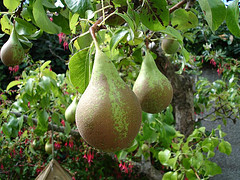Pears
| Infobox on Pears | |
|---|---|
| Example of Pears |  |
| Freshness facts | |
| Optimum carrying temperature | -1,0°C to -0,5°C |
| Highest freezing point | -1,6°C |
| Acceptable product temp. at loading into containers | Max. 2°C above carrying temperature |
| Optimum humidity | 90 to 95% |
| Ventilation setting for containers | 25 m³/hr |
| Storage life | 1-3 months Bartlett (William's Bon Chrétien) 3 months Beurre Bosc 3-4 months Comice 3-6 months Packham's Triumph 4-6 month d'Anjou |
| Climacteric / non-climacteric | Climacteric |
| Ethylene production | High |
| Ethylene sensitivity | High |
| Modified / controlled atmosphere | 0-3% CO2; 1%-3% O2 |
| Potential benefits | Excellent |
| Availability | |
| Australia/New Zealand South Africa South America |
February - July February - July January - June |
Pears
Contents
Harvesting and Handling
Depending on time of harvest, pears are subdivided into early varieties (which reach eating ripeness on the tree) and late varieties (which reach eating ripeness only postharvest). Pears vary in colour from green through yellow-green to yellow. Some varieties are even red in parts. The low fruit acid content in many varieties of pear makes them very sweet.
Pears picked when green have a turnipy taste and tend to shrivel prematurely. Pre-climacteric pears do not ripen easily and remain green and hard, and have a particularly large number of stone cells grouped around the core.
A characteristic feature of pears is their rapid transition from the ripe to the overripe stage. Thus, whenever a cargo of pears is unloaded in the ripe state, large losses are sure to ensue, since within a few days they will be overripe and will lose market value.
Pears are wrapped individually in tissue paper to reduce susceptibility to pressure and impact. They are transported in crates, tubs and cartons. The packaging must allow air circulation for refrigeration purposes. Because of its impact- and pressure-sensitivity, the fruit has to be handled with appropriate care. Packaging in polyethylene bags also has beneficial effects on storage and shelf life, but retards cooling. The fruit must be handled very carefully, since, in the event of strong pressure or jolting/vibration, the fruit rapidly succumbs to bruising and may start to rot within just a few days.
Where possible, the pears should be of uniform size to even out pressure and prevent injury. Size grading is generally performed mechanically.
Quality characteristics and criteria of a properly ripened pear fruit are buttery and juicy texture with the distinct pear aroma and taste of each pear cultivar.
Cooling and Storage
Cooling of pears must proceed as rapidly as possible, to prevent degradation of quality. In pears, the heat of ripening is twice that of apples and approximately four times that of oranges. It is therefore extremely important to bring the cargo as quickly as possible to the necessary travel temperature. This may be achieved by pre-cooling of the cargo. Where a cargo is not pre-cooled, a large-capacity refrigeration plant is required, as the accumulated heat is very considerable.
Pears are less prone to internal breakdown than apples.
Pears are very sensitive to temperature. The storage-life of d'Anjou and Bartlett pears has been reported 35% to 40% longer at -1°C than at 0°C. Intermediate temperatures of 2,5°C to 10°C are harmful to some pear cultivars. 'Bartlett' pears stored at this temperature have dry texture and inferior flavour.
Optimum storage conditions are a temperature of -0,5°C (for early Packham's Triumph) or -1°C for other cultivars.
Winter pear varieties can be stored in CA at -1°C for up to 4 months (Bosc & Comice) or 6 months (Anjou) while maintaining their capacity to ripen and attain good flavour and texture.
Summer pears, including William's Bon Chrétien and Comice, are extremely sensitive to high temperatures, and special effort should be made to maintain the cold-chain.
Precise temperature control is needed to prevent freezing when pears are stored at these low temperatures.
With freezing injury the fruit takes on a glassy, water-soaked appearance. Cutting the fruit in half reveals that the water-soaked part of the flesh of the fruit is located just beneath the skin. The rest of the pulp is unusually dry and sometimes cracked. Freezing injury may set in at a temperature anywhere below freezing point (approx. -2°C). Susceptibility to injury is determined not only by the degree and duration of freezing conditions but also by the physiological state of the fruit.
Mixed loads
Pears generate ethylene and so should not be shipped with ethylene-sensitive commodities such as kiwifruit and persimmons.
Cautions
CO2 levels above 3% are injurious and may cause cavitation, brown core, surface pitting, core cracking or flesh discoloration. O2 levels below 1% may cause brown core, black skin spots or alcoholic off-flavours.
Storage disorders
Alcohol formation, Alternaria rot, Aspergillus rot, Bitter pit, Black rot, Blue mould, Botryodiplodia rot, Breakdown, Brown heart, Brown rot, Brown spot, Bruising, Bulls eye rot, Carbon dioxide injury, Cladosporium rot, Deep scald, Freezing injury, Fusarium, Grey mould rot, Mucor rot, Phytophthora, Pink mould rot, Powdery mildew, Rhizopus rot, Ribbon scald, Russeting, Scab, Sclerotium rot, Soft scald, Sooty blotch, Superficial scald, Water core, White rot.











